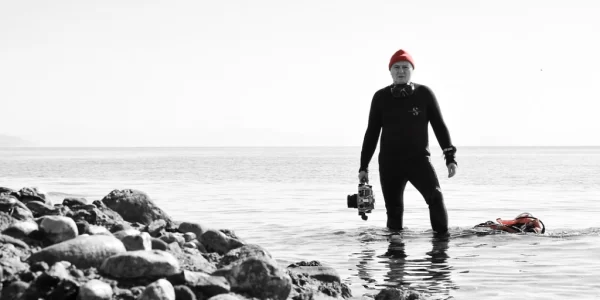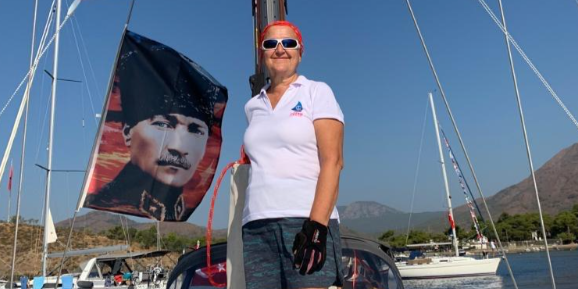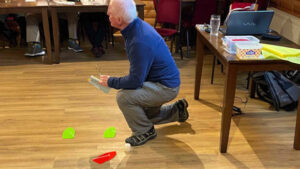It is the intention of the Racing Rules of Sailing to safely get boats around a race course, but how easy is it to know these rules? The answer… it depends.
When Geoffrey Emanuel shared his view for how the complexity of the racing rules was one of the biggest impediments to growing our sport, Scuttlebutt readers submitted the following responses:
Can you write a sailing protocol that is “truly a simplified set of rules”? There is only 100 years of experience that went into the RRS so that boats know what to do when racing. It might be that our culture assumes that someone who has never read the rules, an NOR or SI, should be able to race a sailboat in a “responsible sportsmanlike behavior” on the race course, but I do not think so.
– Peter Glick
This is strong subject for me. I raced Lightnings starting 1987. My children and I enjoyed a lot of racing around central New York. We did a lot of events over the years and participated in District and North American Championships. My kids became adults and moved on, so I sailed with friends, but the fun was gone.
Club racing got super aggressive and the “lawyers on the water” at local regattas were just unbearable. The screaming and yelling at nearly every mark rounding was too much. I finally quit and sold my boat. 10 years on, and I just bought an old Lightning hoping to teach my grandchildren to sail.
I might race a little at a local club, but the thought of picking up a rule book again just makes me cringe. I can’t imagine what it is like for a newbie looking at that thing: pretty daunting for sure!
– Alan McReynolds
Under RRS BASIC PRINCIPLES. Sportsmanship and the Rules. The first sentence says, “Competitors “are expected to follow and enforce” the Rules… deputizing sailors to be a police force, rather than prioritizing sportsmanship.
Related to that is the practice by good friends at the top of the fleet, giving each other mulligans, “You owe me one” to the detriment of beginners and the rest of the fleet.
We’ve been using these modified Rules with our DF95 Racing successfully for 4 years. I presented these rules on an AMYA podcast about a year ago and had a helf dozen other RC Fleets pick up on them.
– Bob Johnstone
Simplifying the rules and regulations of sailing has been a long time quest of US Sailing and most sail associations forever! I Have been involved in this process for more than 45 years; having been a sailor for 64 years. My response to you is that you are right and wrong.
Over the years many clubs and associations have used simple rules to run club races. In general, it has not worked.
The problem is like shoes. Not all sizes fit everyone and not all types can be used on a course. Most race committees try to lessen this by grouping boats into divisions of similar size, weight, length, and design. Even using separation into different levels of sailors’ abilities. This only works when there are enough boats that allow these separations which never happens at a club level when RCs struggle to get eight boats on the line.
Having said that, I do agree that maybe it is time for a beginners set of racing rules. A set that could be used in a general fleet racing, but abstains them from being protested or penalized from the more complicated rules.
This would clearly give them an advantage but that could be a good thing like a handicap. They could be identified as such with a flag they fly so all the other competitors know who they are on the course. At the same time, they would carry an onus to avoid collision or getting into a situation that would lead to a collision.
Clearly, we need to do something to preserve our shrinking sport and grow youth sailing; and support for people who are trying it out. For all the years of my involvement at USSA and other organizations, this has been the #1 topic of debate.
The RRS were first developed solely as a tool to avoid collisions. They have evolved to be a tool in the sailors’ tool kit to win on the race course through the use of tactical insights and boat placement. They are an integral part of the game we play and refined over many years.
We need to be better at teaching the rules!
– Gino Bottino, Past Chair USSA Safety at Sea Committee
I have one word for Geoffrey Emanuel’s comments on the RRS: Hallelujah! Mr. Emanuel, from your mouth to the Racing Gods’ ears! Aside from discouraging potential newbie sailors as Mr. Emanuel recounts (which we clearly see here on Lake Norman), we see another concerning effect: discouraging potential Principal Race Officers.
Between the three major yacht clubs on the lake, we have several “round the buoys” sailors willing to run a race but very few “real” (i.e., certified) principal race officers. Why? The sailors have no problem setting true and interesting courses, proper starting/finishing lines, and starting/scoring races with proper etiquette. But they have little/no interest in having to learn the arcana of the RRS in order to adjudicate a protest committee.
So, increasingly, our Sailing Instructions require on the water resolution of any perceived rules violation (i.e., admit your error and do your turns!) unless there is actual collision and damage. Sailing is already caught in a mega-trend shift to power; anything we can do to make sailboat racing easier to adopt and more fun to participate in will help stave off what seems to be an inevitable decline.
– Wes Bray
Couldn’t agree more. But how do we get from here to there? I would love to see someone take a crack at creating a set of local racing rules.
Of course, the RRS are also for “class” championships, which seem to be dominated by professional crews, to the point that some classes are creating subcategories based on age, nonpro, male/female in attempts to encourage participation.
Racing in a fleet of 30, knowing the top 12 are pros, knowing the best you can realistically hope for is something in the lower teens, can be frustrating. But that has little to do with RRS but may also be something leading to the decline of participation.
Locally, we are arguing about “two vs one” turns for certain fouls. “Two turns is too severe in small keel boats.” What is the purpose of a penalty? All the lawyers that sail also flip into lawyer mode and fruitful discussions about the situations are dead. Closer to addressing the complexity of RRS.
There seem to be a wide variety of “things” killing the sport of racing sailboats from cost, to access, to on water coaching, to on water judging, to alternative on water activities categorized as sailing. If we could get a more straightforward set of rules, that would help.
– Rob Paterson
No, there is nothing wrong with the RRS. They may seem complex, but when you get to the basics, they are simple.
Check out the little RYA Book Handy Guide to the Racing Rules. In the alternative, just look at the pictures in Elvstrom Explains the Racing Rules. I knew what I could do long before I knew a rule number.
In the UK, the boat-on-boat rules are on separate-colored pages so only six small pages and the definitions, not too much to learn. People are lazy; they spend a lot of money even on simple boats but do not bother with the rules.
– Mike Butterfield GBR IU IJ IRO
Geoffrey Emanuel seems loath to study the Racing Rules of Sailing (RRS) written, as he sees it, by an “unaccountable bureaucracy.” On the contrary, the RRS are written to anticipate the myriad situations that arise when a bunch of boats are sailing close to each other. They were not written for “Olympic Racing” but for all the amateur sailors who need to know who has right of way when boats approach each other.
Rather than “wordy” the writers of the RRS parse every word with each revision to make the rules as unambiguous as possible, just as flight controllers and pilots use spare and direct language without extra verbiage. The rules are in no way “nearly intentionally ambiguous.”
It is not enough simply to practice “sportsmanlike behavior and practice humility” in the heat of competition. The challenge of competitive sailing is, in fact, its complexity just as rules and tactics while playing chess are complex. Tactical decisions while racing depend on the rules.
If complexity is bothersome, then cruise and not race. One way to get proficient with RRS is to do imagined simulations of the possible scenarios between the start and the finish line just as a pilot practices on a flight simulator.
– Ron Kallen; Chicago, IL
One of the successes of the Christian religion is its simplicity. There are dense and extensive bibles, but in the end, everything is summed up in 10 Commandments. RSS could be inspired by this simplicity of use.
– Enric Roselló; Barcelona, Spain
Some cycles ago, a bunch of very smart sailors revisited the Racing Rules and “simplified” them. That was the year we got rid of “mast abeam” and changed other rules. My observation at the time, and now, is that sailboat racing is a complex sport and the Racing Rules of Sailing are always going to reflect that, no matter how much we wish it was otherwise.
– Andy Burton
I have generally been trying to avoid commenting on things, but this article has me curious. Before I learned the more comprehensive rules, my father taught me basic right of way and rules of that nature. But even he didn’t know everything. Since I first read the rules, I feel they have become more intelligible, and wonder if it would merit more discussion about how simplistic should the rules be.
How would the rules deal with issues of right of way, mark room, starting, and finishing? The point to any sport or game is to hone skill at it. I’m just a club racer, but I’ve learned that knowing the rules is not only helpful when you are trying to win, but can offer patience when confronted with those who don’t understand as well.
In a race last summer, I was competing against someone who knew some of the rules, but not all of the terminology, so, my knowing the rules was very helpful when all the other skipper was doing was calling out rights without being able to specify what rights he was claiming. I was able to correct my course and give him his rights, and then tell him what he should have said.
But if I didn’t know what was going on, he could scream for rights all day and it would have been meaningless. That doesn’t even address people trying to bluff you or what you do when someone thinks they have room and doesn’t. I will say, if you can make it easier to understand, then by all means do so.
– Bradford Pierce
I agree the RRS are overly complex and difficult to understand by the average racer. I’ve been racing on SF Bay since 1971, been the PRO for over 350 races, and even for a time was a US Sailing Race Officer. Do I understand the RRS nuances? No. But I do understand the basics and have avoided “visiting the room” with several exceptions.
When I was in a protest, I found those visits staffed by arrogant US Sailing Race Officers who assumed everyone involved knew the RRS and interpreted them the way they did. My level of racing was mostly local; I never aspired to Grand Prix level completion where complex rules and lots of yelling were the order of the day. I think a simpler written set of the basic rules would benefit newbies and club racing. And me!
– Patrick Broderick
Having returned to Grade 1 international racing after a long post-Olympics break, I’m shocked to see where the trend to reduce the consequences of rule-breaking as a way to reduce protests have taken the sport.
For example: a single, or even double turn to exonerate a boat for crashing in on port at the windward mark provides such huge net gain for the offender in a large fleet that it has become an all-too-common practice. The consequences of illegally colliding with rule-abiding competitors should be so dire that such maneuvers are simply not worth the risk.
Such a change would require both better refereeing and simpler protest hearing procedures. The latter would be helped significantly by rule and procedural simplifications, though the former would be tougher to accomplish. But in both cases the first step is to embrace a ‘get tough’ philosophy.
– Iain Woolward
Start with the International Safety and Prevention of Collision Laws. There is a high percentage of vessel owners whom have very little knowledge these even exist.
– Ken Hargreaves
We need a set of rules that do not require the Supreme Court to interpret.
I am fairly confident around a race course, but if you ask me what the actual rules are – I am lost. And I have paid for Dave & Daves videos over the years in an attempt to understand the rules better.
New sailors come up to be all the time about learning to race. I can offer a lot of encouragement, technical hints, crew advice, and general how-to. When it comes to rules and the actual wording, when I show them “the book”, their eyes glaze over.
If we had a separate set of very simple club rules, it would be fantastic. Especially for use with JOG/JAM fleets where new sailors are dipping their toes into the water of racing.
– John Marentette, South Port Sailing Club – Race Chair
Ten years ago, when I was active as a national race officer in Sweden, there was no doubt that the racing rules had impact on newcomers. There is not so many sailors aiming at the Olympics, and we all know that sail racing even on national and local level is of great importance for the survival and broadening of the sport. If rule complexity scares people away, we really are moving in the wrong direction.
– Calle Bruno
Our club didn’t even abide by the real rules since at least three versions ago; even when given a copy of the rules they broke. My crew and I sail by the rules no matter where we sail; even if being penalized for doing so on our home lake. That’s what’s killing sailing.
– Yvonne Green Short
Technology is killing everything with people lost in artificial worlds. Sailing requires strength of mind and body that is increasingly in rare supply. The rules are only complicated to negative minds opposed to actually reading and thinking about them.
– Gregory Popp
This article exemplifies a low effort attempt to offer a broad solution to what you perceive to be a majority, (casual racers who don’t want to take the time to learn Part 2) which it’s not, the casual racers are the minority.
That being said, you are asking for help and need a solution to save casual newbies from quitting early on before they can fully appreciate sailboat racing. This I can get behind.
So, let’s make a REAL attempt and try to educate those having trouble with part 2 and apply simplifications when and where necessary, if possible.
First, to understand Part 2 in its current form, with little to no experience requires… The definitions from the front of RRS (there are only 26) and for visual learners, the Call Books for team racing and match racing which can be applied situationally to fleet racing.
Next, know that the ORDER of the rules in Part 2 and its subsections, ARE NOT random. Each rule is “limited” by the following rules in each section and the following sections. It is lazy and contradictory to say the rules are “lawyerly and purposefully ambiguous” at the same time. Each rule specifies the preceding rules to help clarify any situation within a framework that can be followed for any situation, frame by frame.
If you accept the framework which is generally straightforward for sections A, B and D, uncovering the pertinent rules and who is the giveaway boat should be a fairly straightforward task with the help of the aforementioned aids ie. Call Books, which are also organized from start to finish like the order you would sail a race, from start, upwind leg, downwind leg and finish.
But that brings us to the dreaded sections C, or Mark room (rule 18) and Obstruction Rules 19 & 20. These are the focus and hang ups of many competitive racers, let alone the casual newbie, beer can racers who can’t be bothered to learn a situation prior to it occurring in real life.
That being said, rule 18 is almost guaranteed to come up in almost every race somewhere among the fleet so it needs to be addressed.
So, to make our first simplification, the solution you may be looking for, can ironically be found in the Racing Rules of Sailing High Speed addition. (Insert rule 18-20 here in their entirety from this addition into your local SI’s.)
The purpose of the High Speed addition was to address the lack of time to address the nuances of 18, 19 & 20 due to high closing speeds. In other words, the Pros couldn’t think/act fast enough to adhere to the normal rules so they wrote this paired down version. Maybe they can help you.
– Dirk A Johnson
Source: https://www.sailingscuttlebutt.com/2025/01/23/are-the-racing-rules-sufficiently-simple/































































































































































